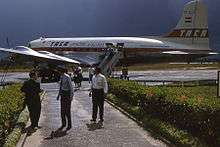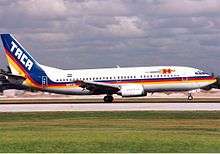TACA Airlines
 | |||||||
| |||||||
| Founded | 1931 (as TACA Airlines) | ||||||
|---|---|---|---|---|---|---|---|
| Hubs | |||||||
| Frequent-flyer program | LifeMiles | ||||||
| Airport lounge | Salones VIP | ||||||
| Alliance | Star Alliance (affiliate)[1] | ||||||
| Fleet size | 41 | ||||||
| Destinations | 50 destinations in 22 countries[2] | ||||||
| Parent company | Avianca | ||||||
| Headquarters | San Salvador, El Salvador | ||||||
| Key people |
Fabio Villegas (President) Roberto Kriete (Chairperson) | ||||||
| Website | www.avianca.com | ||||||

Avianca El Salvador, formerly Transportes Aereos del Continente Americano, simply known as TACA Airlines, is an airline owned by the Synergy Group based in El Salvador. As TACA, it was the flag carrier of El Salvador. As Avianca El Salvador, it is one of the seven nationally branded airlines (Avianca Ecuador, Avianca Honduras, etc.) in the Avianca Holdings group of Latin American airlines. This Airline has been in operation for 75 years.
TACA owned and operated five other airlines in Central America, and its name was originally an acronym meaning Transportes Aéreos Centroamericanos (Central American Air Transport), but this was changed to Transportes Aéreos del Continente Americano (Air Transport of the American Continent), reflecting its expansion to North, Central, South America and the Caribbean.
On October 7, 2009, it was announced that TACA would merge with Avianca,[3] though TACA maintained its name until the merger was officially completed on May 21, 2013.
TACA Airlines was the second-oldest continuously operating airline brand in Central America and the Caribbean after Cubana de Aviación.
Services
The airlines that made up TACA Airlines were:
- TACA International Airlines (El Salvador)
- Aviateca (Guatemala)
- Regional - Formerly Inter, it operates under Aviateca's code.
- Lacsa (LR) (Costa Rica)
- Isleña Airlines (Honduras)
- TACA Perú (Peru)
- TACA Regional
The airline's hubs before Avianca merger were:
- TACA Airlines - Monseñor Óscar Arnulfo Romero International Airport in San Salvador, El Salvador
- TACA Perú - Jorge Chávez International Airport in Lima, Peru
- LACSA - Juan Santamaría International Airport in San José, Costa Rica ended in May 2013
History
Inauguration (1931–80)

TACA was founded in 1931 in Honduras by New Zealander Lowell Yerex. TACA began operations with a single-engine Stinson plane. Since its beginnings, routes covered all the national territory and its aircraft sported the XH Mexican registration (which were changed later by HR). The idea of its founder was to establish one airline in each Latin-American country, such as Aerovias Brasil in Brazil and other TACAs in Mexico, Venezuela, and Colombia.Out of all the TACA franchise airlines created, only TACA International of El Salvador survived,
As a consequence, in 1945 Yerex left the company and TACA moved its headquarters to the Republic of El Salvador where it was modernized and expanded, the company then established investment groups in other Latin American countries to be sold to domestic airlines, which in the case of Honduras TACA was sold to SAHSA. Later TACA was organized as an international company having its headquarters in San Salvador only under the name of TACA International Airlines.

During the 1940s and 1950s, the airline began to acquire larger piston engine airliners including the Douglas DC-3 and the Douglas DC-4. The Vickers Viscount turboprop passenger airliner followed in order to expand its route network around the Americas.
On 28 December 1966, TACA Airlines entered the jet age when it inaugurated their first jet, a BAC One Eleven (which was a popular airplane at the time with other airlines in Latin America). The aircraft model was used until June 1, 1988, when it was phased out in favor of the Boeing 737-200 aircraft. The Lockheed L-188 Electra four engine turboprop airliner was operated from 1976 by TACA Air Cargo including freight flights to Miami, Florida.
Expansion years (1980–2009)

Until 1980, TACA was owned by a United States company and had its corporate headquarters in New Orleans (due to the civil war raging in El Salvador) under the administration of the Kriete Family of El Salvador, who owned a minority stock and ended up buying all the shares.
The airline also made several upgrades in the fleet during the 1980s, by substituting the much older turboprops and One Eleven airliners with more efficient aircraft, such as the 737-300 and Boeing 737-400 of the Boeing 737 Classic series and its predecessor, the Boeing 737-200 Advanced.
Between 1940 and 1995, TACA bought the majority shares of the flag carrier airlines of Guatemala (AVIATECA), Costa Rica (Lacsa), and Nicaragua (NICA), consolidating operations under a new brand name, Grupo TACA.
In the 1990s, TACA Airlines became the launch customer and principal users of the Airbus A320 model in Latin America. These aircraft were substitutes for the aging Boeing 737-200 and the 737-300/-400 series aircraft that were on the fleet, which were gradually retired until 1999.

In 1992, TACA signed a strategic alliance with Panama-based Copa Airlines, and the airline began flying to Tocumen International Airport, making it the first flight connection center in Latin America. As a consequence, Tocumen airport became the "Hub of the Americas" and the integration of several Latin American airlines to the alliance, such as LACSA, Aviateca, and NICA took place. The alliance ended in 1998 after the six-year period established in the agreement expired.
Then in 2001, having its main hubs in San Salvador, El Salvador, and San Jose, Costa Rica, the airline set an operations base at Lima, Peru, its first base in South America, causing as a consequence the founding of TACA Peru, of which TACA had 49% shares at. With this new addition, Grupo TACA began to offer a comprehensive network of routes throughout the Americas.
In 2005, TACA Airlines was one of the founding members of the Mexican airline Volaris. In the same year, TACA became the first airline of Latin America to operate the largest version of the A320: the Airbus A321.
In 2008 the board of directors decided to revert to the original name, TACA International Airlines (since the consolidation of the acquired airlines was completed), and the airline' headquarters returned to San Salvador, El Salvador to a new building which was inaugurated shortly afterwards. Also, it revealed a renovation in its corporate image.
That same year, TACA became the second user of the Brazilian Embraer E-190 in Latin America.
AviancaTaca and modernization (2009–12)

In October 2009, it was announced that TACA Airlines would merge its assets in a strategic alliance with Colombian airline Avianca, in which case each will maintain its own trademark and operations. Avianca and TACA Airlines operated a combined fleet of 129 aircraft, serving over 100 destinations in several countries in America and Europe.[4] In December 2009 approval for the merger was given by the Colombian Civil Aeronautical Agency.[5] The merger of Colombia's Avianca and El Salvador-based TACA is the latest sign that consolidation in the Latin American airline sector is picking up.
In November 2009, the airline's Chief Executive Fabio Villegas announced that the airline was looking to replace its Fokker 50 and Fokker 100 aircraft with newer aircraft of 100 seats or less. The 10 Fokker 50s and 15 Fokker 100s were operated on flights shorter than one and a half hours.
Brazil's Embraer, Canada's Bombardier Aerospace, and the Airbus A318 were being considered for the replacement.[6]
In December 2010, the airline made the decision to retire the Fokker 100 aircraft in 2011 and replace them with 10 Airbus A318 leased from GECAS from 2011-2018. The aircraft were delivered during January to February 2011.
In December 2012, the airline made an firm order to ATR for 15 ATR 72-600 aircraft with a total value of 700 million dollars and the deliveries to start June 2013.[7] The purpose of this purchase is to replace the aging Fokker 50 aircraft.
Star Alliance (2010–12)
On November 10, 2010, Star Alliance announced that Avianca and TACA Airlines were to become full members in mid-2012.
Completion of merger and final flight
Avianca and TACA completed their merger on May 21, 2013. On May 20, 2013, just before midnight (12:00 AM), TACA Airlines began to remove all its signs bearing the TACA logo from airports across the US, Canada, Mexico, Central America, South America, and the Caribbean. However, most of the former TACA Airlines Airbus and Embraer jets as well as the TACA Regional jets still have the TACA logo painted on it. These aircraft are expected to be painted with the Avianca logo at a later date. The last flight with the TACA callsign took place on May 20, 2013. The flight was TACA flight 566 from Monseñor Óscar Arnulfo Romero International Airport in San Salvador to John F. Kennedy International Airport in New York City. It departed San Salvador at 7:50 pm MST and landed in New York at 2:35 am EST. The flight landed two hours and thirty-five minutes after the official re-branding of the airlines; thus, the flight departed with the TACA callsign and landed with the Avianca callsign. The final official TACA flight to have the TACA callsign was TACA flight 520 from San Salvador to Los Angeles International Airport in Los Angeles. This flight departed at 7:20 pm MST and landed at 11:50 pm PDT. The first flight departing operated by Avianca El Salvador took place on May 21, 2013. The flight was Avianca El Salvador flight 561 from San Francisco International Airport in San Francisco to San Salvador. The flight departed at 1:25 am PDT and landed at 7:55 am MST. This was followed by Avianca El Salvador flight 521 from Los Angeles to San Salvador. This flight departed at 1:30 am PDT and landed at 7:30 am MST.
Merger and controversy in Costa Rica (2012–13)

On October 10, 2012, it was reported in a press conference that the trade name TACA Airlines was going to disappear from the public eye and the promotion and marketing strategies were going to be owned by Avianca, according to representatives of the group that controls the brand. The Avianca-Taca's CEO, Fabio Villegas, explained that the use of the single brand for the group would occur in the first half of 2013.[8] Eventually the TACA trade name wouldn't disappear from the public eye TACA will continue to operate but it will operate under the Avianca El Salvador brand and it will remain a full member of Star Alliance.
On May 18, 2013, the Avianca-Taca Holding group downgraded the Juan Santamaría International Airport Hub in San José, Costa Rica to a base of operations as part of post-merger restructuring. This included the discontinuation of more than five non-stop flights made by the airline to and from San Jose, including flights to all cities in the United States. As a consequence, more than 200 employees lost their jobs (equivalent to 20% of the work force of the airline). This was controversial in Costa Rica and led to an extensive investigation by the civil aviation authorities of that country against the holding company.[9][10][11]
Corporate affairs
Avianca El Salvador has its headquarters in Santa Elena.[12]
Destinations
TACA Airlines serves 28 destinations throughout North, Latin, and South America.
Codeshare agreements
The airline has codeshare agreements with the following airlines:[13]
Fleet
Parent company Avianca has a firm order for 100 Airbus A320neo family aircraft, and some of the aircraft will likely go to Avianca El Salvador.[14] The Avianca El Salvador fleet consists of the following aircraft (as of August 2016):[15]
| Aircraft | In Service | Orders | Passengers | Notes | ||
|---|---|---|---|---|---|---|
| C | Y | Total | ||||
| Airbus A319-100 | 8 | — | 12 | 108 | 120 | — |
| Airbus A320-200 | 18 | — | 12 | 138 | 150 | — |
| Airbus A321-200 | 6 | — | 12 | 182 | 194 | — |
| Airbus A330-200 | 1 | — | — | |||
| Embraer 190 | 8 | — | 8 | 88 | 96 | — |
| Total | 41 | 0 | ||||
Historic fleet
TACA Airlines operated the following types:
Reciprocal frequent-flyer agreements
LifeMiles is the frequent-flyer program of Avianca and TACA Airlines as of 2009, because of the merger with Avianca. It replaced the old "Distancia" program.[21]
Accidents and incidents

- On March 5, 1959, Vickers Viscount YS-09C crashed shortly after take-off from Managua Airport, Nicaragua when both port engines failed. 15 of the 19 people on board were killed.[22]
- On May 24, 1988, a Boeing 737-300 operating as TACA Flight 110 to New Orleans suffered a double engine flame-out due to water ingestion, a result of an in-flight encounter with an area of very heavy rain and hail. The design of the engines and FAA water ingestion certification standards did not take into account the higher water volume of strong or severe thunderstorms while operating at lower power. The plane landed without further damage on a grass levee at the NASA Michoud Assembly Facility. All 45 passengers were uninjured.[23]
- On April 5, 1993, a Boeing 767-200 operating as TACA Flight 510, overran the runway at Guatemala City's La Aurora International Airport due to an inability to brake on the flooded runway.
- On May 30, 2008, an Airbus A320, registration EI-TAF, operating as TACA Flight 390, from San Salvador overran a rain-soaked runway on landing at Toncontín International Airport in Tegucigalpa, Honduras. There were 5 fatalities, 2 of which were on the ground.[24]
References
- ↑ Archived January 17, 2012, at the Wayback Machine.
- ↑ "Nuevos Vuelos TACA Airlines 2009". YouTube. 2009-09-03. Retrieved 2015-02-24.
- ↑ "Avianca confirms 'strategic merger' with TACA - 10/7/2009". Flight Global. 2009-10-07. Retrieved 2015-02-24.
- ↑ "Latin American airlines to merge". BBC Online. BBC. 2009-10-09. p. 1. Retrieved 2009-10-08.
- ↑ "Poder 360° - Page One Daily News - Avianca and Taca Merger Approved". Poder360.com. 2009-12-03. Retrieved 2013-06-04.
- ↑ "Avianca looking to replace Fokkers". Eturbonews.com. 2009-11-30.
- ↑ "Avianca-Taca encargan 15 aviones regionales ATR por $700 millones". Terra.com. 2012-12-13. Retrieved 2012-12-21.
- ↑ "Nombre TACA desaparece del fuselaje de los aviones - ECONOMÍA - La Nación". Nacion.com. 2012-10-11. Retrieved 2013-06-04.
- ↑ juuber (2013-05-18). "AviancaTaca reorganiza vuelos y elimina 261 empleos en Costa Rica - Revista Estrategia & Negocios". Estrategiaynegocios.net. Retrieved 2013-06-04.
- ↑ "Aviación Civil afirma que Avianca suspendió vuelos sin avisar - EL PAÍS - La Nación". Nacion.com. 2013-05-25. Retrieved 2013-06-04.
- ↑ "Costa Rica: Reestructuración de Avianca afecta mercado aéreo". Aeronoticias.com.pe. 2013-05-27. Retrieved 2013-06-04.
- ↑ "1993 | 0648 | Flight Archive". Flightglobal.com. Retrieved 2015-02-24.
- ↑ "Profile on Avianca El Salvador". CAPA. Centre for Aviation. Archived from the original on 2016-11-01. Retrieved 2016-11-01.
- ↑ "Avianca firms up order for 100 A320neo Family aircraft". Airbus. Retrieved 25 February 2016.
- ↑ "Global Airline Guide 2016 (Part One)". Airliner World (October 2016): 13.
- ↑ "Aviation Companies, Brazil, Columbia, Costa Rica, Cuba & Mexico". Smithsonianeducation.org. Retrieved 2015-02-24.
- ↑ Archived April 23, 2006, at the Wayback Machine.
- ↑ Archived November 18, 2005, at the Wayback Machine.
- ↑ "Photos: Airbus A300B4-203(F) Aircraft Pictures". Airliners.net. 2001-06-14. Retrieved 2015-02-24.
- ↑ "Home of Cincinnati Aviation Heritage Society". Cahslunken.org. Retrieved 2015-02-24.
- ↑ "LifeMiles – El programa de viajero frecuente de Avianca, TACA y AeroGal". Lifemiles.com. Retrieved 2013-06-04.
- ↑ "Accident description". Aviation Safety Network. Retrieved 11 September 2009.
- ↑ Archived November 10, 2013, at the Wayback Machine.
- ↑ "Plane skids off runway in Honduras, 5 dead". Reuters. May 30, 2008. Retrieved 2008-05-30.
External links
| Wikimedia Commons has media related to Avianca. |